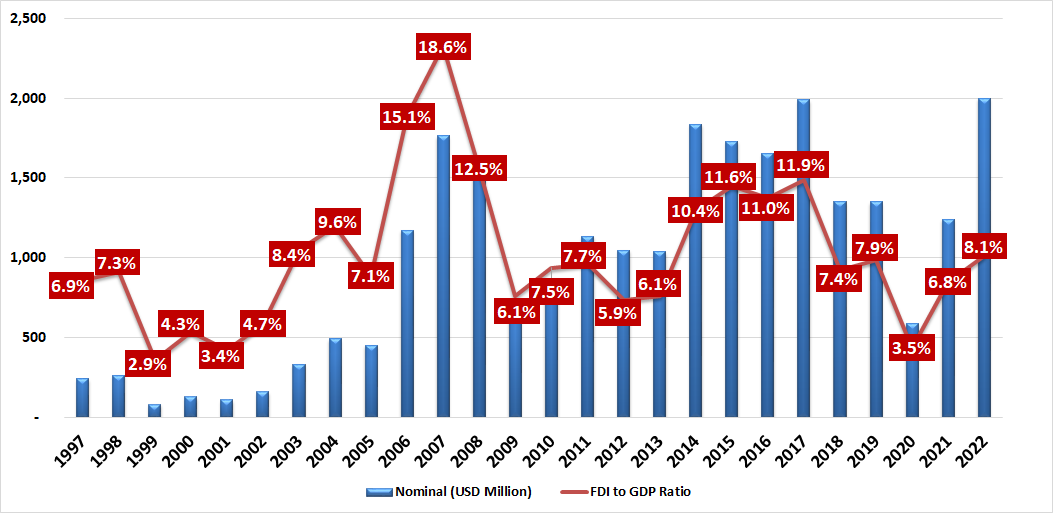Government of Georgia: “Foreign direct investments increased by 61% to USD 2 billion and reached a historic high.”
Verdict: FactCheck concludes that statement published on the Government of Georgia’s Facebook page is Manipulation.
Resume: According to the information of the National Statistics Office of Georgia, foreign direct investments in Georgia reached exactly USD 2 billion in 2022 which is 61% higher as compared to 2021’s data and constitutes a historic high as a nominal figure. However, another key indicator – the FDI to the GDP ratio – also needs to be taken into account. In 2022, Georgia’s economy amounted to USD 24.6 billion whilst the FDI to the GDP ratio was 8.1%. This figure is very far from being a record high since the FDI to the GDP ratio exceeded 8.1% four times in a row in 2014-2017 and peaked in 2017 at 11.9% under the Georgian Dream’s rule. However, this is also not a record high figure. In 2007, the FDI to the GDP ratio was 18.6%. FactCheck concludes that statement published on the Government of Georgia’s Facebook page is a MANIPULATION.
Analysis
The Government of Georgia’s Facebook page published information that Prime Minister Irakli Gharibashvili held and chaired a session of the Economic Council. The publication ends with the statement: “It was stated during the meeting that the volume of foreign direct investments in 2022 increased by 61.1% and reached USD 2 billion which is a historic high of foreign direct investments in the country thus far.”
The National Statistics Office of Georgia has been compiling data on foreign direct investments to Georgia from 1996, although we can ignore the starting year of 1996 since the volume of investments then was merely USD 4 million. Throughout this entire period, a total of USD 25.3 billion in investments was made in Georgia and the largest nominal amount of investments – at USD 2 billion – was made in 2022. Until 2022, record high investments were made in 2017 and notably, the difference between these two figures is only USD 9 million.
During the whole reporting period (26 calendar years from 1997 including 2022), foreign direct investments exceeded USD 1 billion 14 times and USD 1.5 billion seven times. Prior to the recalculation, it was considered that investments made in in 2007 amounted to USD 2.015 billion; however, after changes in the methodology, this figure was adjusted to USD 1.765 billion. The National Statistics Office of Georgia clarified that changes were made in line with the International Monetary Fund’s recommendations.
Apart from the nominal figure, it is necessary to take the investment’s share in the total economy into account when measuring investments. In 1999, Georgia’s total economy was USD 2.8 billion. FDI in the amount of USD 1 billion would have been a strong impetus for massive growth. In 2022 when the nominal economy reached USD 24.6 billion, FDI in the amount of USD 1 billion would have been something of a negative context. Given real economic growth, each invested USD has different purchasing power and importance as compared to ten or even 20 and 25 years ago. Based on purchasing power alone, USD 1 in Georgia 20 years ago is more as compared to USD 2 today.
If we measure the FDI to the GDP ratio, which is a central pre-requisite for seeing the full picture, we will see that the ratio is 8.1%. This means a tenth position instead of a first. The FDI to the GDP ratio in 2003, 2004, 2006, 2007, 2014, 2015, 2016 and 2017 exceeded 8.1%.
Graph 1: Foreign Direct Investments in Georgia

Source: World Bank
If the FDI to the GDP ratio had been the same as what it was in 2017, then investments should have exceeded USD 2.9 billion in 2022 whilst the FDI to the GDP ratio it should have reached USD 3.7 billion in 2006 and USD 4.5 billion to reach the record 2007 figure.
Foreign direct investments in Georgia are cyclical which is mostly, but not always, related to large infrastructural projects like the Baku-Tbilisi-Ceyhan oil pipeline, the Shah Deniz gas pipeline or the Karsi-Akhalkalaki railway. The situation would have been different had large HPPs and the Anaklia seaport been built in respective timeframes, although these projects were not realised for various reasons.
The finance and insurance sectors account for the largest portion – USD 526 million – of investments in 2022, followed by real estate as the interest surged nearly tenfold from USD 42 million to 407 million. Water supply waste management is in the top three fields with USD 197 million.
Among the investor countries, the UK is at the top with USD 428 million, followed by Spain and the USA with USD 367 million and USD 164 million, respectively.
The reason why Spain is ranked the second in the top investor countries as well as why water supply is second biggest recipient of FDI is the Spanish Aqualia company’s acquisition of 80% of GWP’s shares. The 870% hike in real estate is almost certainly related to the growth of migration from Russia which cannot be explained by any improvement of the real economic situation.
The part in the Government of Georgia’s Facebook publication which says that FDI increased by 61% as compared to 2021, reached USD 2 billion and broke the record (as a nominal figure) is true. FactCheck believes that although the figure in the statement is accurate, the full context is distorted and the picture is provided in a manner so as to leave the reader with a wrong impression. The nominal amount of FDI in 2022 is only slightly higher as compared to the previous nominal record whilst the 2022 indicator is in the tenth place in terms of the FDI to the GDP ratio. Therefore, FactCheck concludes that statement published on the Government of Georgia’s Facebook page is a MANIPULATION.








